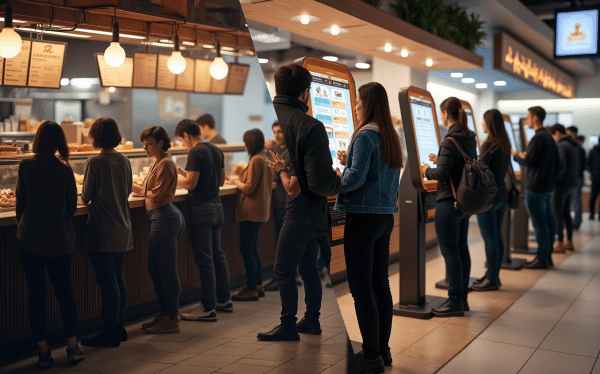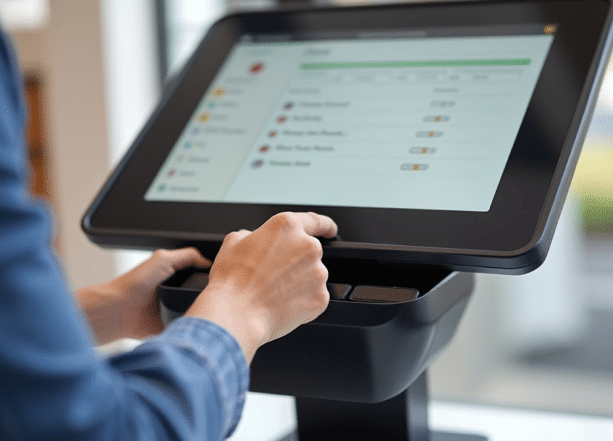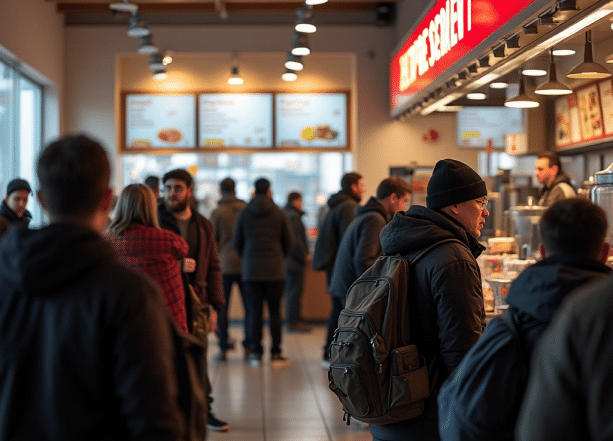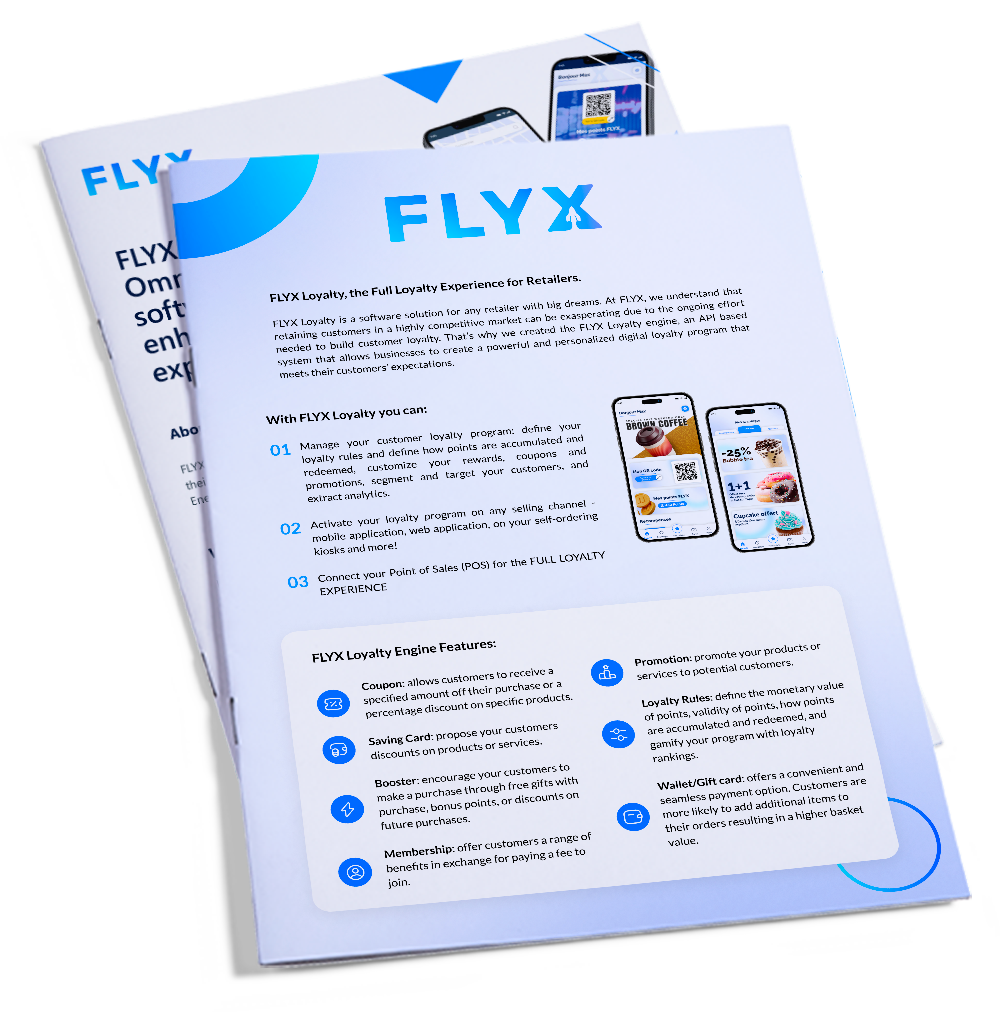Request here a brochure to find out more about our services !
Queue Management Systems and Strategies
In an era where convenience and efficiency matter more than ever, efficient customer flow management is crucial for businesses striving to provide outstanding customer service. A well-implemented queue management system serves as the foundation for enhancing the customer journey, ensuring a seamless and satisfying experience.
The benefits of a queue management system are extensive. From reducing average wait times and boosting customer satisfaction to optimizing operational efficiency and increasing revenue, these systems can significantly transform how businesses handle queues. By adopting the best queue management system, companies can streamline the traditional queuing process into a more customer-friendly approach.

Queue management lies at the heart of any customer-centric strategy. Whether managing a single retail line or a complex series of government service windows, effectively managing queues ensures that customers feel valued, informed and in control of their waiting experience. Proper queue management can help reduce wait times, prevent overcrowding and ultimately improve overall service quality.
In this article, we will explore advanced queue management strategies and their benefits, showcasing how they keep customers happy and engaged.
Self-Ordering and Self-Service Kiosks: A Central Strategy
Self-ordering and self-service kiosks have become a cornerstone of modern queue management, revolutionizing how customers interact with businesses and dramatically reducing wait times. By offering customers a direct way to place orders or access account information, these kiosks streamline service delivery and minimize staff involvement in repetitive tasks. From restaurants to retail outlets and government agencies, organizations worldwide are implementing self-ordering kiosks to drive operational efficiency and improve the overall customer experience.

In quick-service restaurants and C-stores, for instance, self-ordering kiosks help reduce lines, minimize order errors and free up employees to handle more specialized tasks. Many kiosks come equipped with loyalty program integration and upselling features, further enhancing the user experience while increasing revenue opportunities.
Moreover, self-ordering kiosks can integrate seamlessly with virtual queueing solutions for an even more efficient process. Customers may join a virtual queue on their mobile devices, receive alerts when it’s their turn and then finalize their transaction using a kiosk. This synergy between virtual queueing and self-service kiosks substantially shortens lines, accelerates service and lowers customer frustration. Real-time automated notifications further reduce anxiety and enhance customer satisfaction by keeping customers informed throughout the waiting period.
Self-service kiosks also significantly contribute to business growth by enabling data collection that helps understand customer behavior and preferences, facilitating targeted promotions and personalized experiences. By gathering customer feedback directly at the kiosk, businesses can quickly identify areas for improvement, further enhancing customer service excellence.

Additionally, these kiosks can efficiently manage peak hours by distributing customer flow more evenly throughout service locations, leading to better resource utilization and cost savings. Integrating these self-service solutions with existing queue management software ensures smoother customer journeys and improved staff performance.
Overall, the strategic deployment of self-ordering and self-service kiosks creates a more streamlined, efficient and personalized queue management process, delivering great service while meeting and exceeding customer expectations.
Other Key Components of Advanced Queue Management Systems
Virtual Queueing Solutions
Implementing advanced queue management systems, particularly those that incorporate virtual queueing solutions, can significantly enhance the customer’s waiting experience and operational efficiency. Virtual queueing solutions allow customers to join a queue remotely, using their mobile devices or other internet-connected tools. This approach is particularly beneficial in reducing physical wait times and making the experience easier to manage for both service providers and customers.

Real-time Updates and Alerts
One of the key features of advanced queue management software is the ability to provide real-time data updates and alerts to customers. This transparency is essential in managing customer expectations and reducing frustration related to average wait times. Many systems offer real-time queue status updates and estimated wait times, which can be displayed on customer devices or on-site monitors. These updates help customers feel more informed and valued throughout the waiting process.
Additionally, such solutions often include operational insights that help businesses identify peak times and optimize their resource allocation, further enhancing operational efficiency. Real-time updates also facilitate better communication between customers and staff. For instance, some platforms enable staff to manage queues more effectively through detailed queue metrics and trends analysis, while customers benefit from real-time queue status notifications.
Frustrated Customers
Long or disorganized queues often lead to frustrated customers. One key objective of advanced queue management is to minimize frustration by keeping customers informed, offering them alternative waiting methods (like virtual queuing) and personalizing their experience. When customers feel their time is respected, frustration levels drop, creating a more positive environment for both customers and staff.

This real-time data helps in optimizing contact center operations and improving overall service quality. By implementing these advanced features, businesses can create a more streamlined, efficient and customer-centric queue management process that enhances the overall customer experience and drives operational excellence.
Enhancing the In-Queue Experience
Enhancing the in-queue experience is important for maintaining customer satisfaction and reducing the perceived waiting time. One effective way to achieve this is by incorporating engaging activities and content within the queue. Digital displays plays a significant role here, as it can showcase a variety of content to keep customers entertained and informed.

For instance, businesses can use digital display to show news updates, weather forecasts, or even entertaining videos. This not only keeps customers engaged but also helps in creating a more positive atmosphere. According to Vizitor, displaying engaging content such as news or calming visuals can improve customer mood and patience, making the waiting experience more tolerable. Additionally, queue-based displays can be used to promote products or services, provide helpful tips or offer special offers.
Improved Layout and Navigation
The layout and visual guides of the queue are critical components in enhancing the in-queue experience. A well-designed queue layout can significantly impact customer flow and overall satisfaction. To start, it is essential to establish a clear entrance and exit to prevent cross-flow of traffic, ensuring both efficiency and safety.
Clear and concise signage (generally refers to any kind of visual graphics or displays) is vital for guiding patrons through the space. This signage should be visible from the entrance, allowing customers to see the destination and understand where they are heading. High-visibility signage and an evacuation system are also important for easy navigation and safety in emergencies.

The placement of signage is equally important. Signs should be positioned at key points in the queue, such as the entrance, turns and near points of interest. This strategic placement ensures that signs are visible and not obstructed by other objects, providing continuous guidance and information to customers as they move through the queue.
Moreover, the queue layout should be designed to minimize unnecessary barriers or excessive turns, which can give the impression of a longer waiting time. A direct route to the destination makes customers feel they are progressing towards their goal without any backtracking.
Accessibility is another important aspect to consider. The queue should be designed to be inclusive, allowing easy access for all customers, including those using wheelchairs, walkers or motorized scooters. Ensuring that the queue is accessible demonstrates a commitment to inclusivity and efficient service, further enhancing the customer experience.
Waiting Area
The waiting area is a vital extension of the queue itself. A comfortable, well-organized waiting area can drastically reduce perceived wait times by keeping customers at ease. Whether through seating arrangements, digital signage, or interactive displays, businesses that invest in enhancing their waiting areas often see higher satisfaction rates. Clear signage pointing to the waiting area also helps direct foot traffic efficiently, preventing bottlenecks.
By combining engaging activities, improved layout design, and effective signage, businesses can transform the in-queue experience into a more positive and efficient part of the customer journey.

Personalizing the Customer Queue Experience
Personalizing the customer queue experience is a powerful way to enhance customer satisfaction and loyalty. This can be achieved through the integration of customer data into the queue management system. By leveraging customer data, businesses can create a more tailored and relevant experience for each individual.
For instance, using customer feedback solutions, businesses can send personalized offers, promotions, or recommendations via email, SMS, or mobile apps. This personalization can extend to the queue itself, where customers can be greeted by name and their specific preferences can be acknowledged. For example, if a customer has dietary restrictions or scheduling preferences, the virtual queuing system can ensure relevant options are highlighted or offered during their wait.

Additionally, integrating customer data with queue management solutions allows for more effective and personalized customer communication. Bi-directional communication features from modern platforms enable staff to send personalized messages to customers at various stages of their journey. This could include welcome messages, updates on queue status, or even farewell notes, all of which contribute to great customer service and a more engaging experience.
Priority and Scheduled Queuing
Implementing priority and scheduled queuing can further personalize the customer experience by catering to different customer needs and preferences. Priority queuing allows businesses to assign different levels of priority to customers based on various criteria, such as the nature of their visit or their loyalty status.
This scheduled approach also helps in managing peak times and ensuring that customers are served promptly, enhancing their overall experience. By combining data integration, personalization, priority queuing, and scheduled queuing, businesses can create a highly personalized and efficient queue management process that aligns with the unique needs and expectations of their customers.
Conclusion
FLYX offers an innovative approach to queue management through self-service kiosks designed to improve customer flow and streamline the customer journey, ensuring exceptional service quality. These solutions effectively reduce waiting times, optimize resource utilization and foster business growth by consistently meeting and surpassing customer expectations.
Adopting advanced queue management systems is critical for enhancing customer experience and operational efficiency. Virtual queuing solutions and real-time updates play a key role in significantly reducing wait times and boosting overall customer satisfaction.
Personalizing the queue experience through data integration and priority queuing further tailors the service to individual needs. Enhancing the in-queue experience with engaging activities and improved layout design also plays a vital role.
To summarize, effective queue management involves advanced technology, personalized service, and a well-designed queue layout. By adopting these strategies, businesses can create a seamless, efficient and customer-centric experience. Take action today to transform your queue management process and see the positive impact on customer satisfaction and operational excellence.
Get our brochure !
